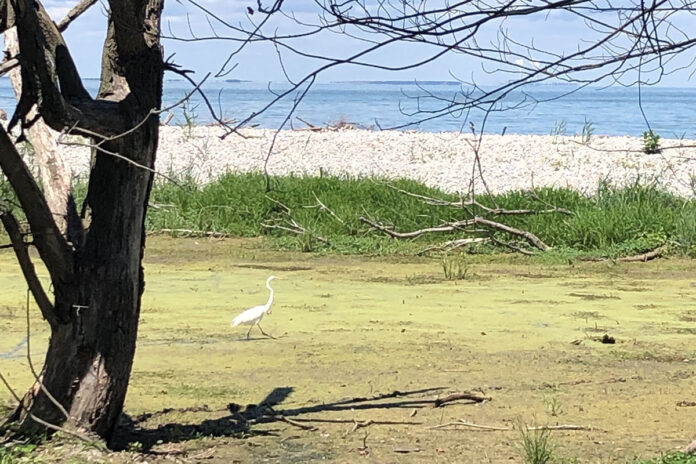
Because we have family living in southeastern Michigan, we make a trek across the entire Ohio turnpike once or twice a year. When the rolling hills subside and groves of trees transition into flat fields of corn and soybeans, I know we are getting closer to our destination.
I never really thought about the history of the region. I assumed that the land was settled similarly to the rest of the state. Trees were probably cleared as settlers moved west.
Murky past
Little did I know that the golden fields used to be filled with muck and called the Great Black Swamp. It is such an unappealing moniker, but it could be worse. It could have been named the “Land of a Million Mosquitoes.”
Oozing with knee-deep mud and buzzing with swarms of mosquitoes, the Great Black Swamp covered what is now 10 counties in northwest Ohio extending from Sandusky into Indiana.
A layer of clay underground formed a barrier retaining moisture in the top layer of the soil. Without elevation changes, the flat land drained very poorly to four rivers: the Sandusky, the Maumee, the Auglaize and the Portage.
The earliest settlements, starting with the Native Americans, were formed at the edge of the Great Black Swamp. The area was mostly avoided until a route was needed between the Western Reserve and areas of settlement in what is now southeastern Michigan.
A very unsuccessful attempt at a road was made in 1823 when Congress approved the creation of the Maumee and Western Reserve Road from Sandusky to Maumee.
Travelers often preferred traversing by boat across Lake Erie or going north into Ontario over driving the new road. It had a reputation for being the worst road in the country.
The canal era did not bring much growth to the area or establish reliable transportation. Crews of workers fell victim to various illnesses, including malaria from the swarms of mosquitoes.
Meaningful changes
It wasn’t until the iron beast of a railroad rammed its way into the region that any meaningful changes affected the landscape.
The earliest farmers began to sell lumber for profit, using many of the trees in the swamp. Professional lumberjacks came to the area to fell trees and sell the lumber. The wood was used for various reasons such as building ships and railroad ties. Farmers also used wood to create drains by nailing two boards together like an inverted trough.
Interestingly enough, the clay that was part of the problem was used to create a solution. The clay was easily accessible and used in the manufacturing of drain tile. By 1880, there were 11 tile factories in Putnam County.
Continued logging, digging of ditches and the use of tile were transformative. The Great Black Swamp quickly transitioned into nutrient-rich farm fields.
Maumee Bay State Park
While traveling to Michigan, we decided to explore the area that used to be the Great Black Swamp at Maumee Bay State Park. The boardwalk trail, leaving from the Nature Center, gave us an up-close look at the ecosystem along the shoreline.
The two-mile all-access trail was completed in 1993 by the Ohio Civilian Conservation Corps. Crews worked year-round in hip-deep muck, snow and ice to create a trail for visitors to walk through a forest and a wetland. The area has seen many transitions.
I visited about 18 years ago and instantly realized a lot had changed. The most notable change was the loss of tall trees in the forest. The invasion of Emerald Ash Borers killed most of the native Green Ash trees starting in 2003.
In recent years, lake water has flooded the area, killing many maple trees. On a positive note, woodpeckers and other cavity-dwelling birds have made their way back to the boardwalk area to thrive in the transitioning habitat.
Even with the loss of trees, we were still able to see a variety of wildlife. From the bird viewing area of the Nature Center, we observed the stillness of a blue heron in the water. A red-winged blackbird perched on a reed blowing in the wind. Muskrats quickly munched on vegetation amid sticks and mud. A pair of doves circled around cattails.
Looking toward the lake, we watched as a great egret gracefully walked across the shallow water looking for its next meal. The area has seen drastic transitions in the past and will continue to do so in the future.
Beneficial initiative
As a part of H2Ohio, a comprehensive water initiative launched by Gov. Mike Dewine, a project is underway to eradicate invasive species in the wetlands of Maumee Bay State Park. The goal of the project is to control existing phragmites through water level management.
The addition of a water control structure will allow water from Lake Erie to access the wetland. The benefits gained are filtered nutrients and the ability for fish to enter the wetlands, both from Lake Erie.
In addition to the H2Ohio initiative, the boardwalk will be completely rebuilt beginning in January of 2023. Other recent upgrades to the park include a new playground at the beach/day use area.
The region may have a dark past starting with the Great Black Swamp, but the future is clean and bright.












